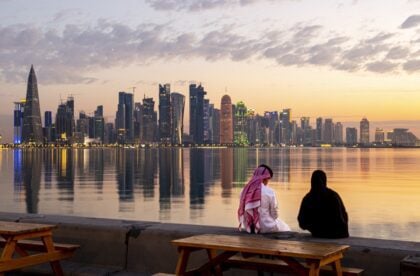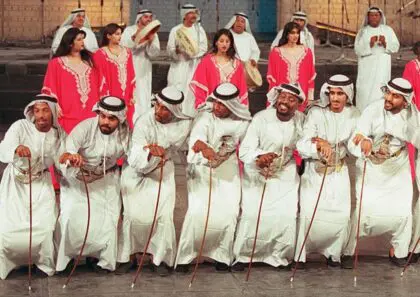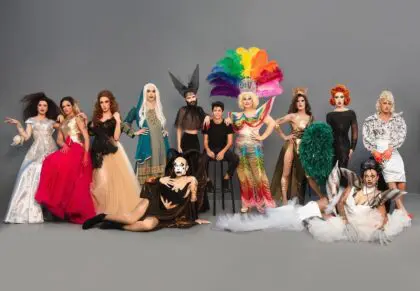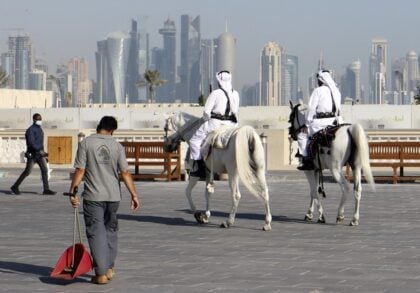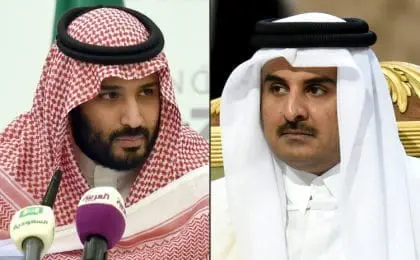
Introduction
Qatar has a rich heritage, shared with the entire Arab Gulf region, especially this region’s contributions through thousands of years worth of experience of crafts and arts. According to researchers, during the pre-oil era, the Qataris’ cultural product was drawn from the relation between Qataris and the professions they practiced, such as hunting, diving, sniping, grazing and agriculture. And so, this relation produced signing, dancing, handicrafts and interconnected and homogeneous social behavior.
As for the culture that prevailed in the Arabian Peninsula in general during the post-oil era, it was basically a f oreign culture in its, brought to the Gulf region by the economic and social developments, which was manifested in introducing modern techniques, accompanied by specialists of their respective fields, and manifested in the imported technology that brought the culture of its origin.
Due to that, life in Qatar is a mixture of modernity and the traditions drawn from its ancient culture. While Qatari cities are rich with modern characteristics, manifested in luxurious facilities, infrastructure and architecture, its heritage, traditions and culture are still embodied in all the details surrounding this modern life.
Theatre was introduced to Qatar in the 50s through cultural salons, and witnessed the true birth of theatre in the 60s when the first theatre group “Qatari Theatrical Troupe” was founded in 1972, and remained the only theatrical troupe until 1994, then three more Troupes were formed, which are “Al Sadd Theatrical Troupe”, “The Lights Theatrical Troupe” and “Folk Theatrical Troupe”.
Despite being relatively young compared to Arab and global art movements, Qatar’s fine art movements witnessed a distinguished epoch since the last two decades of the second millennia, thanks to Jassim Zaini, the founder of the Qatari fine arts movements in the 1960s.
Music in Qatar – as the rest of the Gulf countries – depend on sea songs drawn from folklore, and after establishing the Musical Institute which provided musical education to young people, alongside the introduction of modern musical instruments, the Qatari song has evolved just as all songs in the rest of the Gulf countries.
Qatar has a chain of various museums, most significant of which is the National Museum of Qatar in the capital “Doha” that won the first Aga Khan Award for Architecture (1978 – 1980), and it is considered an architectural and artistic masterpiece. It houses a variety of traditional and historical artifacts from Qatar and the region, apart from being an important source of culture.
To learn more about the culture of Qatar, check what Fanack has covered about this file.
Qatar's National Culture

The recently renovated Qatar National Museum in Doha exhibits a range of interesting artefacts and local antiquities. These are almost invariably presented as typical examples of Qatari tradition.
But does ‘Qatari’ tradition really exist? It is important to realize that the National Museum was originally set up by the Qatari government – shortly after independence – with the aim of creating a ‘national narrative’.
The institution and its collection had to present a shared history and culture for the new state’s citizens in order to further the political process of nation-building and the creation of a shared identity.
In a region where common borders are sometimes still subject to controversy, the definition of a national culture is a daunting task. In many ways, it really does not make sense to speak of a specific ‘Qatari’ culture or tradition. Even when interpreted in a restricted sense, as relating only to ‘nationals’, problems soon arise.
The troublesome identification of a specific ‘Qatari’ dialect can illustrate this point. This could be understood to be the locally dominant form of speech, that of the prominent Sunni families of Doha. However, the Bahrani – or Shia Arabs – of Doha speak a very different dialect, related to the language of the Bahrani of Bahrain and Saudi Arabia. The identification of a ‘national’ dialect therefore excludes the Shia citizens of Qatar from their ‘own’ national culture.
Furthermore, it ignores the fact that Sunni Arabs from Qatar, the UAE, Bahrain and Kuwait speak a very similar dialect, commonly known as Gulf Arabic.
Importing Arab Culture
Language, art and artefacts may be given a national label, but that does not automatically make them a specific ‘local tradition’. Travellers in the Gulf should not be surprised if the very same architectural feature is described as ‘traditionally Qatari’ in Doha and ‘traditionally Bahraini’ in Manama.
Western observers even point to an opposing, globalizing trend in the Gulf region: that Gulf culture is gradually being replaced by a sometimes rather artificial ‘pan-Arab culture’. With this term, they are alluding to the increasing cultural influence of the Levant and Egypt and even of ‘orientalist’ artists in the West.
London especially has become a centre for exporting ‘Arab culture’ to the Gulf. British publishers and writers produce coffee table books which give a sanitized and romanticized picture of Gulf culture and history. These locally flattering, but all the same simplistic and stereotypical productions, are often financed by Gulf sheikhs and Western oil companies, who distribute them as ‘heritage’ gifts among expatriates and locals alike.
‘Arab’ art
According to the American anthropologist Christa Salamandra, who recently published an interesting article titled ‘Cultural Construction, the Gulf and Arab London’, Western orientalist art is very popular among Gulf nationals. The currently fashionable yearning for ‘the old times’ among Gulf nationals is partly satisfied through the import of highly clichéd Western paintings of the ‘Arabian’ desert, carpet sellers or souks. According to one Londonart seller, Gulf Arabs prefer to buy ‘Arab’ art in London.
The same goes for ‘Islamic’ art. For a few happy, carefree years, the young Qatari collector Sheikh Saud Al Thani – President of the National Council for Culture, Arts and Heritage of Qatar until his dismissal in 2005 pending an investigation on misuse of public funds – showered the metropolitan art market with millions of dollars on a collecting spree.
The Sheikh assembled an extensive ‘Islamic’ art collection abroad – most of which was meant to be exhibited in the new Museum of Islamic Art in Doha, just off the Corniche near Doha Port, which was designed by the Chinese architect I.M. Pei. At the eastern end of the Corniche the Qatar National Museum is housed in the historical Fariq al-Salata Palace, built in 1901.
The Qatar Photography Museum, further down the Corniche in al-Bidda, will almost certainly astonish visitors with its ‘flying stingray’ design.
Local Dress

Dress is a means to express one’s individuality and identity. The main item of dress for Qatari males is the thawb (plural: thiyab), a smart ankle-length shirt very similar to that worn in Bahrain and Kuwait. In summer Qatari men wear light, white thiyab, but in winter the fabric of the shirt is heavier and has a darker colour, using different shades of grey, brown or ochre.
The bottom hem of the thawb is generally folded over, and the sleeves are cuffed with buttons or cuff-links. The thawb, under which Qatari men wear a shirt and sirwal, protects the body from loss of moisture in a hot environment.
On formal occasions a light, black or brown cloak or bisht is worn over the thawb, usually draped loosely over the left shoulder. The collar and lapels of the bisht are generally embellished with heavy gold thread embroidery, which is hand sewn and then beaten with a mallot. Badu sometimes wear a heavier camel-hair bisht.
Ghutra
Most adult Qatari men wear a circular skull cap, the keffiyeh, which resembles lace. This is topped with a headscarf, the ghutra or shemagh.
The ghutra is usually white in summer and checkered in winter, either red and white, less frequently black and white, and only occasionally shows alternative combinations such as white and green, white and blue, or white and orange.
The square headscarf is folded diagonally and fastened with a double black coiled and knotted rope known as an agal. Some agal are worn with one or two tails hanging down, depending on the fashion. The ghutra can be wrapped around the face in cold weather or when the shamal occurs, offering additional protection.
The style of the ghutra depends on both individual preferences, age, weather and national differences. It is removed during prayer.
The male national costume is adorned with typical accessories which – like the type and quality of the thawb, bisht and ghutra – are highly indicative of an individual’s local status and wealth. Jewellery, watches, pens and sandals are important accessories.
Many men also carry prayer beads, or misbah, in their pockets
Women in Qatar usually wear the black abaya, a loose-fitting garment with long sleeves, although some fashions such as the farasha (butterfly) or the ‘fish’ style might be more tight-fitting. Younger women can increasingly be seen wearing Western-styled clothes beneath their abaya, which might be made of a transparant fabric. Accessories such as jewellery, handbags and red or silver sleeves add colour to their garments.
According to the requirements of the Koran and the Hadith, women should cover their entire body, excepting their face, hands and feet, when in public. Qatari women are however increasingly showing their faces in public, sometimes revealing part of their hair and necks. The most common head scarf worn is the hijab, a square scarf which is folded and which covers the hair and neck.
The batula, which is very typical of this part of the Gulf, is generally worn by older women, and symbolizes family status and respectability. The different styles of the batula range from a coarse piece of black cloth with a fold for the nose and small holes to see through, mostly worn by Bedouin women, or more elaborate, gold-coloured covers, which are primarily worn by wealthier urban women. The niqab also covers the face, except for the eyes.
Sports
With almost no wildlife left to hunt in their own country, Qataris have to go abroad to pursue the most famous and glamorous of traditional Arab sports: falconry. Camel and horse racing are also popular, although almost exclusively as spectator sports. Racing camels were traditionally ridden by extremely young foreign jockeys, but heightened sensitivity to Qatar’s image in the world press has led to their recent replacement by robots. Young Qataris get a kick out of driving their cars at high speed at night, competing with friends in showing off their most daring driving styles. Off-road driving in the desert is also a popular local activity.

Unmarried boys and men play popular sports such as bodybuilding, football and basketball. In effect, a large number of Qataris are merely passive spectators, who do not accept to engage in sporting activities that require more physical effort. Perhaps for this reason, the government is pursuing a policy of importing and resettling first-class athletes from East African countries mainly, with the aim of winning international medals in international sporting events. In October 2020, Qatari’s national football team ranked 57 in FIFA’s world ranking table.
Qatar is a forerunner in the current trend for nations to acquire talented athletes. It literally bought its Olympic Team for Beijing 2008. Most prominent among these athletes is the Kenyan-born steeplechaser Stephen Cherono – now Saif Saaeed Shaheen – who was reportedly offered a USD 1,000 dollar monthly cheque for the rest of his life by the Qatari government. Likewise, the greatest stars and the coach of Qatar’s national football team were born in either Brazil or Uruguay.
The country is also eager to host major international sporting events. In 2006, it successfully hosted the Asian Games. Its bid for the 2016 Olympics was controversially turned down by the International Olympic Committee in the spring of 2008, but Crown Prince Tamim has vowed to bid again for 2020. Qatar won the bid for the 2022 FIFA World Cup. The country currently hosts an annual International Sailing Regatta, the Tour of Qatar Cycling Race, the ExxonMobil Qatar Open Men’s Tennis Tournament, the Commercialbank Qatar Masters Golf Tournament, and a MotoGP at the Lusail racetrack – which is planned to be converted into a Formula 1-racetrack as soon as possible
Latest Articles
Below are the latest articles by acclaimed journalists and academics concerning the topic ‘Culture’ and ‘Qatar’. These articles are posted in this country file or elsewhere on our website:


